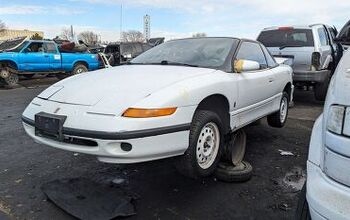GM's IPO: For King, Country, or Cadillac?
After ending the first quarter of this year with $35.7b in cash and equivalents, GM was in the best position it’s enjoyed in decades. And yet, with an IPO prospectus looming, The General is seeking a $5b line of credit and trotting out EBITDAPRO as its in-house measure of financial success. Both of these tactics are hallmarks of companies that are doing poorly, and GM has already learned how problematic loading up on debt and sliced-and-diced financials can be. So why is The General inviting criticism from outlets like Edmunds Autoobserver, which characterizes GM’s push towards an IPO as the rebirth of old bad habits? The simple answer: “business execution.” In other words, GM may have a lot of cash, but it’s got nearly as many demands on its resources as well… and these cash drains hardly add up to a coherent strategy.
GM still has yet to announce its Q2 financial performance, but already it’s clear from anecdotal evidence that GM is spending a lot more money than it has in several years. Much of it is going to marketing, as GM sponsorships have re-emerged post-bankruptcy for everything from Public Broadcasting to the giveaway of Corvettes to baseball players and business leaders. With a new marketing boss, GM is also re-shuffling its ad agencies, and has been buying up ads for new products like the Buick Regal, as well as older products with sagging sales, like the Chevy Corvette. Add increases to R&D for a number of canceled powertrain programs ($42m of which had been written off as losses at the end of last year) and the development of a number of potentially expensive new products (more on this in a bit) and you’ve got a sure-fire recipe for rising costs.
Meanwhile, GM’s sales have remained relatively stagnant. “Core brands” were up nearly 32 percent in the first half of 2010, but overall GM is outperforming its H1 2009 performance in US-market sales by a mere 13.2 percent, as the economy falters mid-recovery. Against a backdrop of sharply-increasing costs in marketing and R&D, the underlying mechanics of GM’s business are a crunch that will eventually require either another cutback in long-delayed marketing or R&D spending, or a real turnaround in sales not driven by profit-sapping fleet sales.
And that’s just the background to GM’s real dilemmas. The General will need to spend about $6b on its Opel and Daewoo divisions in this year alone, a move that will cut its cash pile by at least a fifth. Since these divisions develop the platforms and products that have made GM competitive once again, The General can’t afford to not keep them open, and no government seems willing to step in and help out.
Meanwhile, The General needs to be saving cash for a rainy day as well: it will have to pay $5.9b in unfunded pension costs in 2013, and another $6.4b in 2014. That’s roughly $18b of GM’s $30b cash pile spoken for before a single new car is developed, not counting any operating losses accrued along the way.
And new car development is a must if The General’s turnaround is to stay rolling along. Powertrains are one area where GM is said to be spending big money, and a new generation of full-sized trucks and SUVs are also in the works. A whole new RWD platform, known as Alpha, is under development at Cadillac and is said to provide the underpinnings for Cadillac’s new 3-Series competitor (ATS) as well as the next-gen CTS and Camaro. Though the costs for these projects aren’t being released, it seems safe to assume that capital expenditures in Q2 and beyond should accelerate significantly from Q1’s $800m number simply on the strength of these investments.
And here’s where it gets interesting: with Chairman/CEO Ed Whitacre now running product planning, a RWD Cadillac flagship is coming back onto the table, backed internally by both Whitacre and GM NA boss Mark Reuss. Though a modified Zeta platform is under discussion for the range-topper, GM had previously declared the platform unfit for luxury car duty, and there are reports of a new RWD platform known as “Beta” under development at GM Shanghai. If a new platform is being developed, the cost could easily amount to another billion dollars (if not more), which begs the question: does GM need a full-blooded flagship? How this plan impacts the Epsilon II+ XTS “flagship” that is probably even further along in development isn’t clear; the XTS was supposed to be the cheap route to a Caddy flagship, but now it seems more likely to be canceled or become a hybrid-only model.
But while Whitacre dreams of a world-class RWD Cadillac (and purportedly fights for the Chinese-market RWD Buick Park Avenue to come stateside), yet another force is stirring beneath GM’s feet. With the election of Bob King, the United Auto Workers have taken a distinct turn towards the internationalist left, as the union struggles for relevance in the post-bailout environment. And with profits at Ford inspiring talk at the UAW of rolling back long-overdue concessions, any sign of consistent profits by GM by next year’s bargaining session will be seen as an excuse for King’s fired-up negotiators to put the squeeze on GM. Especially if the union is able to dump most of its VEBA account holdings of GM equity, it would have no compunction in once again bleeding the goose that lays golden eggs.
In short, GM’s expenditures are rising even as sales remain sluggish. After a solid five years of starving powertrain and platform development, GM conservatively faces $5b in annual capital expenditures, plus an additional $6b in annual expenditures for 2010, 2013 and 2014 to maintain its pension plan and overseas divisions. That accounts for The General’s $30b cash pile right there, before making the investments needed to fulfill Ed Whitacre’s desire to make Cadillac a world-class luxury brand, or accounting for demands made by a newly invigorated UAW led by Bob King’s firebrand vision. Either of these could add billions to GM’s survival bill, especially during the 2011-2012 respite from pension and overseas obligations.
And then there’s the final piece of the puzzle: what this all spells for the government’s 61 percent stake in GM. Because of political pressure to exit its unwanted investment as soon as possible, the Treasury’s priorities are last in the growing line for GM’s cash pile. This is hardly surprising given that the cash came from Treasury in the first place, but GM also can’t ignore the deleterious effects that a huge taxpayer bath would have on its image with consumers. GM doesn’t owe Treasury full payback out of a moral obligation, but because its potential customers are footing the bill for their turnaround. With King, Country and Cadillac all lining up for a piece of GM’s dwindling cash pile, someone is going to get left out in the cold.
So, what’s a bailed-out automaker to do? Holding a hard line on the union is crucial, as it’s the one component of this balancing act that can be taken for granted (on the other hand, British Leland). And as much as we disdain GM’s plan to saddle Cadillac with the mass-market platform-derived XTS flagship, there’s no guarantee that Whitacre’s cherished RWD flagship would be worth the $1b-$2b it would cost to develop. If anything, GM should prioritize taxpayer payback for the simple reason that its obligation to the taxpayer (rather than, say, the fact that the government controls its day-to-day decisions, which it doesn’t) is a significant factor in its sluggish sales relative to Ford.
But the fact that GM is pursuing a $5b line of credit and diving into an IPO indicates that GM is willing to take a hit on its initial valuation and let Treasury take the loss, rather than forgo a number of expensive new development programs. This will serve only to extend GM’s financial burden beyond the 2014 window for its pension obligations, further hurting its long-term investment value. And this debt also hurts its short-term value compared to Ford, because the Blue Oval’s overleveraged balance sheet is one of the only things that makes GM look good by comparison.
With King, Country and Cadillac all lining up for GM’s liquid assets, it’s too soon to abandon austerity measures in the RenCen. There are more than enough tough choices ahead for General Motors.
More by Edward Niedermeyer
Latest Car Reviews
Read moreLatest Product Reviews
Read moreRecent Comments
- Jalop1991 There is no inflation. Everything is cheaper than it was 5 years ago. SHRIMP AND GRITS!
- ChristianWimmer Exterior and interior look pretty flawless for such a high mileage car. To me this is an indication that it was well-maintained and driven responsibly. It’s not my cup of tea but it’s bound to find an enthusiastic owner out there.And with ANY car, always budget for maintenance.
- Fred I'm a fan and watch every race. I've missed a few of the live races, but ESPN repeats them during more reasonable hours.
- Mikesixes It has potential benefits, but it has potential risks, too. It has inevitable costs, both in the price of the car and in future maintenance. Cars with ABS and airbags have cost me at least 2000 bucks in repairs, and have never saved me from any accidents. I'd rather these features were optional, and let the insurance companies figure out whether they do any good or not, and adjust their rates accordingly.
- Daniel Bridger Bidenomics working.

































Comments
Join the conversation
i dont think the problem is in gm's line-up, because they do have competitive product. and they do have the sales. i think it has more to do with gm having 2 seperate r&d centers (daewoo & opel). both develope small, compact and midsized platforms, so they overlap. basically, gm has double the costs. they should somehow converge it all. btw, a new cadillac flagship would be nice. make the xts.
GM's turnaround is an illusion. The pressure is on Nobama to land on the aircraft carrier and announce 'mission accomplished'. The rush to IPO is part of this. The attempted murder of Toyota is another. When the government divests itself of the millstone around it's neck known as GM and Chrysler the UAW will be told, "you got your payback" now sink or swim. With all the NHTSA and the Whitehouse have done for the union, King has to keep the momentum up and not let the flames go out. Hence the farcical picketing of Toyota dealers complete with rodents and bad english. He's wasting his time and union resources but he is a politician of the same ilk as Obama, all show and no go and as long as everyone thinks he is doing a great job he will be left alone. Even after all the 'restructuring' and bailout cash, GM is still not sufficiently changed to be competitive and as Buickman was said, they still do not know how to sell cars. They say that old habits die hard and some don't die at all until the body they inhabit itself dies. Such is the fate of GM. This bailout has just postoned the inevitable. The next time it will be straight to CH 7, do not pass 'go' and do not collect bailout bucks!